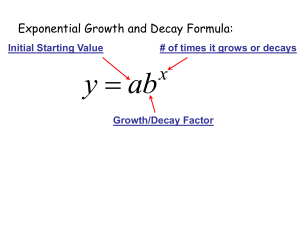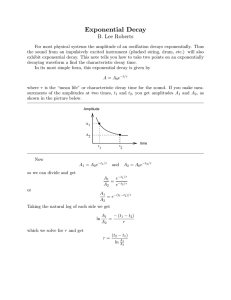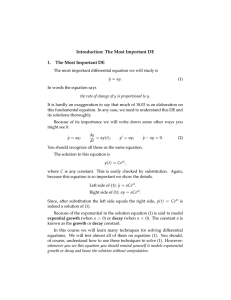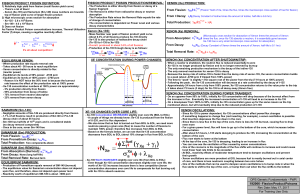The exponential growth and decay equation describes a change in
advertisement
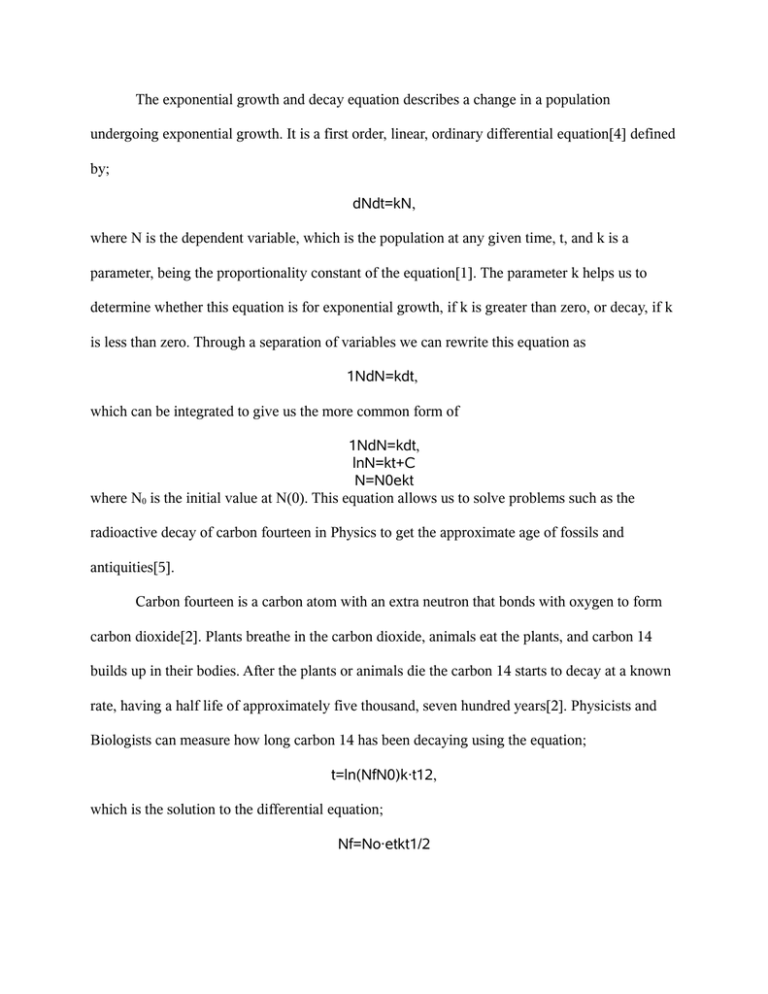
The exponential growth and decay equation describes a change in a population undergoing exponential growth. It is a first order, linear, ordinary differential equation[4] defined by; dNdt=kN, where N is the dependent variable, which is the population at any given time, t, and k is a parameter, being the proportionality constant of the equation[1]. The parameter k helps us to determine whether this equation is for exponential growth, if k is greater than zero, or decay, if k is less than zero. Through a separation of variables we can rewrite this equation as 1NdN=kdt, which can be integrated to give us the more common form of 1NdN=kdt, lnN=kt+C N=N0ekt where N0 is the initial value at N(0). This equation allows us to solve problems such as the radioactive decay of carbon fourteen in Physics to get the approximate age of fossils and antiquities[5]. Carbon fourteen is a carbon atom with an extra neutron that bonds with oxygen to form carbon dioxide[2]. Plants breathe in the carbon dioxide, animals eat the plants, and carbon 14 builds up in their bodies. After the plants or animals die the carbon 14 starts to decay at a known rate, having a half life of approximately five thousand, seven hundred years[2]. Physicists and Biologists can measure how long carbon 14 has been decaying using the equation; t=ln(NfN0)k∙t12 , which is the solution to the differential equation; Nf=No∙etkt1/2 Where t1/2, is the half life of carbon 14 and k is equal to approximately -0.693. These equations and the theories behind them are useful for determining the age of fossils and other organic antiquities up to sixty thousand years. The same idea and equation is used with other elements that naturally occur in human bodies with larger half lives such as potassium 40, which has a half life of approximately 1.3 billion years[2]. Another useful equation is used to determine the amount of energy produced by a nuclear fission reaction, which is given by the equation E = Ea2(n-1) where E is the amount of energy produced by the reaction, and 2(n-1) is the amount of atoms that have split to provide the energy, with n being equivalent to the generation of splitting[5]. The generation of splitting refers to the number of times an atom has undergone fission to produce energy. It is important to know how much energy is produced by fission because it shows just how efficient a fission reaction is. For example, the amount of energy that is provided by a single kilogram of uranium-235 is found to be 8.2x107 kJ's, which is roughly equivalent to 3000 tons of coal.[3] We can use this information to help find more efficient and sustainable forms of energy, preserving our natural resources. For scientists it is important to understand the exponential growth and decay formula and the implications it can have on society. Using this equation helps scientists date artifacts, which leads to a better understanding of the history of the Earth. The use of the exponential growth formula also helps to find and create efficient energy systems with Nuclear Fission reactions. It is more a part of our lives than we could possibly know, and understanding it helps us use it to our advantage. References [1] “Introduction to Exponential Growth and Decay”, Physics Tutorials, Jan 11th 2010 <http://www.physics.uoguelph.ca/tutorials/exp/intro.html> [2] “How Carbon Dating Works”, How Stuff Works, Jan 11th 2010, <http://science.howstuffworks.com/carbon-141.htm> [3]Petrucci, R.H.; Harwood, W.S; Herring, F.G.; Madura, J.D. General Chemistry with an Organic Supplement Volume B. 2007 [4] Nagle, R.K; Staff, Edward B.; Snider, David, Fundamentals of Differential Equations, 7th edition, 2008 [5] Serway, Raymond A.; Jewett John W. Physics for Scientists and Engineers, vol. 2, 7th edition, 2008 Marissa Holmberg Max Hewitt

